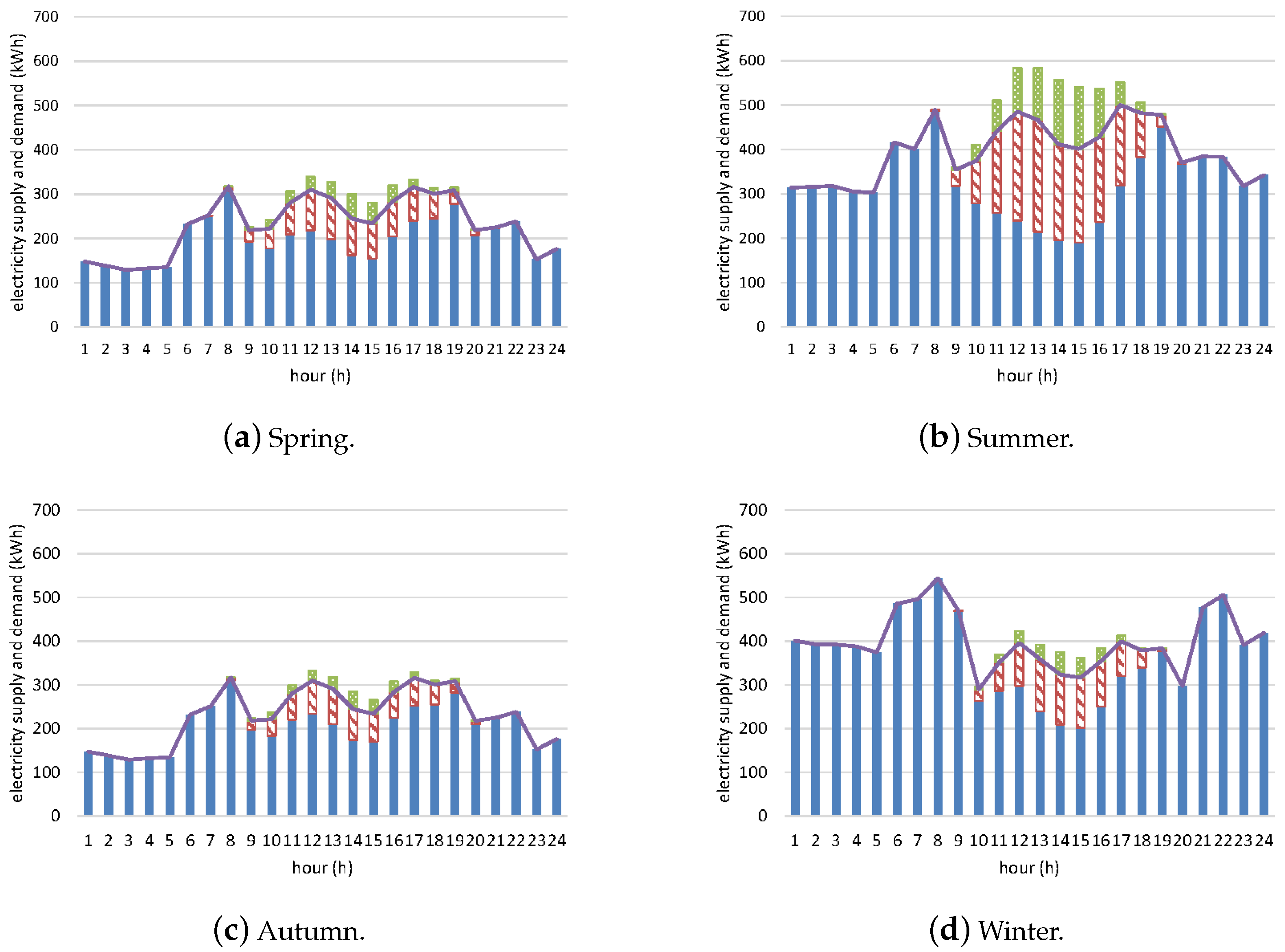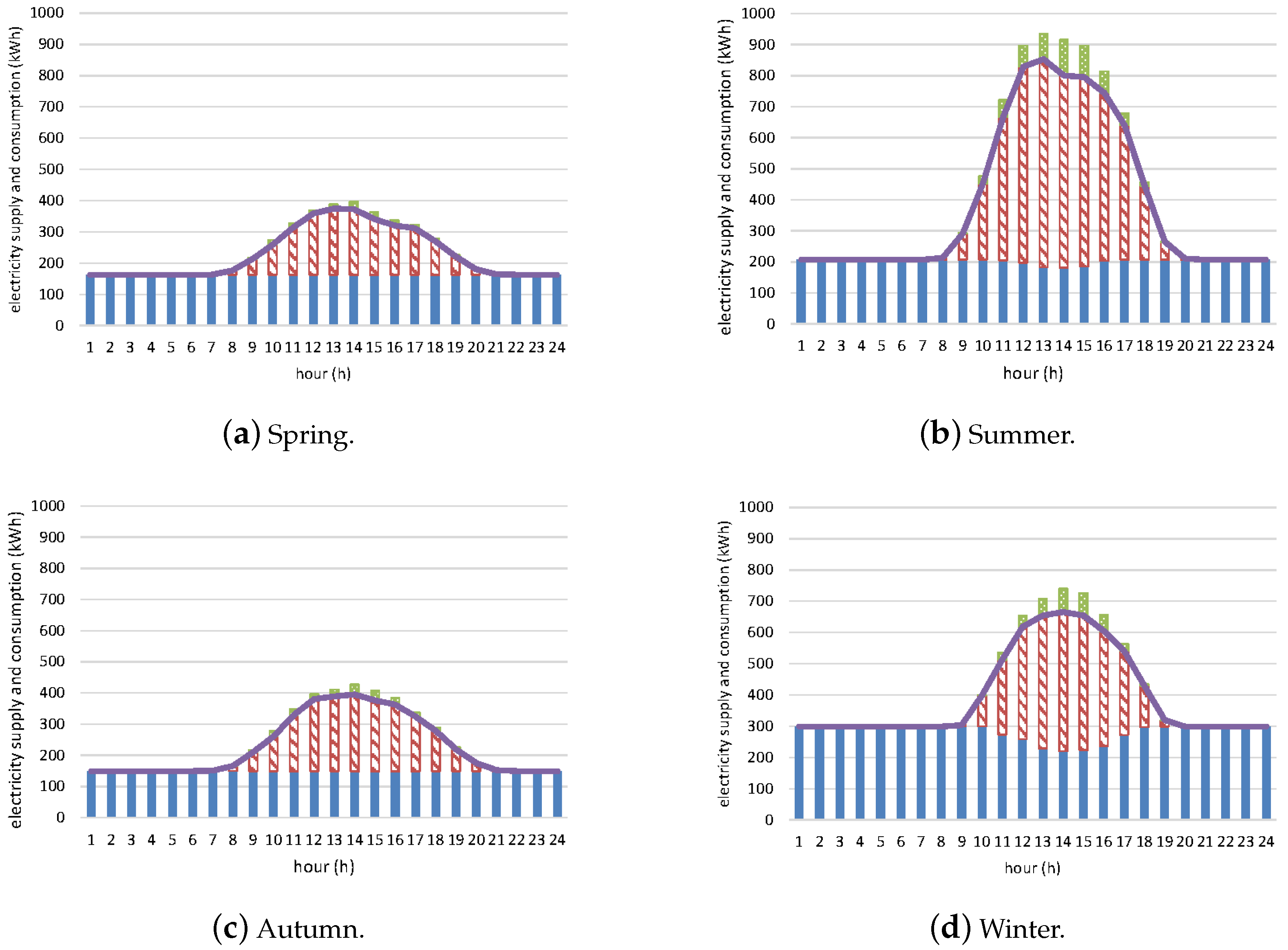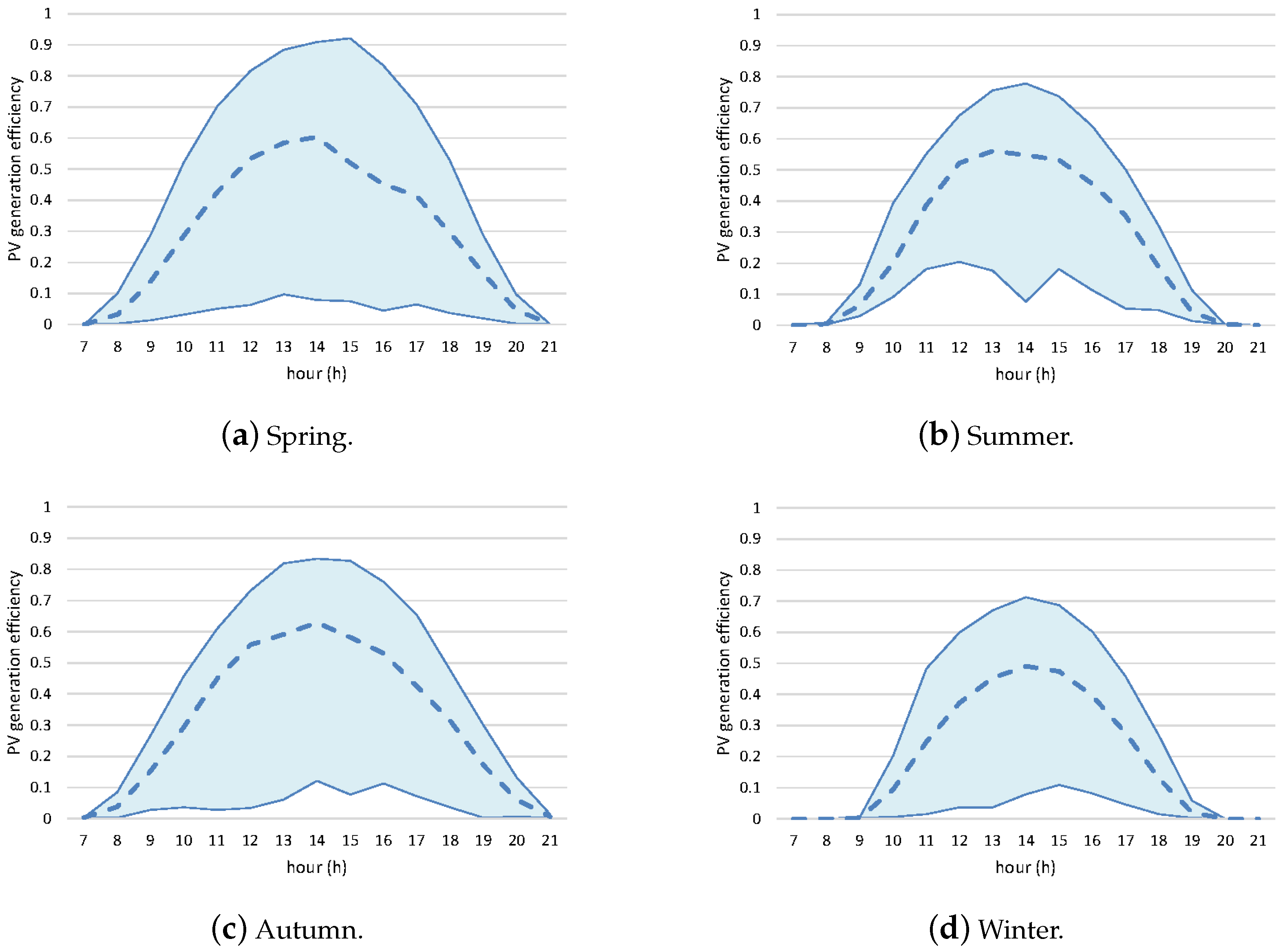1. Introduction
Solar photovoltaic (PV) has become the most installed renewable energy technology, and the global cumulative installed PV capacity exceeded 1200 GW in 2023, more than doubling since 2018 [
1]. Solar PV generated approximately 1300 TWh around the world in 2022, which contributes approximately 5% to the world’s total electricity production [
2,
3]. With a net-zero scenario by 2050, the International Energy Agency (IEA) projects solar PV generation will be approximately 14,000 TWh by 2050, which contributes around 29% of global electricity production by 2050 [
4]. The global expansion of PV installations has been driven by supportive policies such as feed-in tariffs in various countries, the increased manufacturing scale of PV panels leading to cost reductions, and the Paris Agreement, which has boosted the global commitment to renewable energy.
PV installation in South Korea (hereafter Korea) also has increased more than fifteen times from 1.3 GW in 2014 to 20.2 GW in 2022, the electricity generation of which was 30.7 TWh, contributing approximately 5% to the Korean total electricity production [
5]. Compared to wind turbines, PV produced more than nine times the electricity in 2022. PV is a leading renewable energy technology also in Korea.
In establishing the Basic Plan for Long-Term Electricity Supply and Demand (a 15-year plan updated every 2 years, referred to as BPE in this paper), the Korean government has continuously upgraded its implementation plans to achieve greenhouse gas reduction goals in the power sector. In particular, the aggressive introduction of “Renewable 3020”, which increases the share of renewable generation to 20% by 2030, was first made in the eighth BPE (2017) to respond to the climate change crisis [
6]. According to the most recent 10th BPE (2023), it was announced that PV capacity would be expanded to 34.0 GW [
7], which projected 62.3 TWh electricity generation contributing 10.4% to the Korean total electricity production in 2030 [
8].
Solar PV installations are categorized by ownership type: utility-scale, commercial and industrial, and residential installations. Utility-scale installations refer to large-scale solar power plants typically owned and operated by utilities, independent power producers, or specialized renewable energy companies. As of 2023, around 60–65% of the total global photovoltaic (PV) capacity, equivalent to 720–780 GW, comes from utility-scale installations [
1,
9]. Commercial and industrial installations consist of PV systems installed on commercial buildings, factories, warehouses, and industrial facilities. Commercial and industrial installations can be owned directly by businesses or by third parties who sell the electricity back to the business under power purchase agreements or leasing agreements. There are also shared solar projects where multiple businesses or individuals invest in or benefit from a single PV installation. The estimated capacity of commercial and industrial installations is approximately 20–25% of the total global PV capacity in 2023, amounting to 240–300 GW [
9,
10]. Finally, residential installations consist of small-scale PV systems installed on individual homes and residential properties, which are about 10–15% of the total global PV capacity, equating to 120–180 GW [
10,
11].
In China (the world leader in PV installations with over 400 GW in 2022), the majority of installations are utility-scale projects owned by state-owned enterprises and large private companies, while residential and commercial installations are increasing due to supportive policies [
12]. European countries have mostly focused on commercial and residential installations, especially in Germany, Italy, and the Netherlands, while a growing number of large-scale installations are considered in Spain and France [
13]. In the United States, there is balanced and robust growth across all types of installations: utility-scale at 67%, commercial and industrial at 10%, and residential at 23% in 2023 [
14].
Studies have shown that Korean consumers mostly prefer solar power over wind power and bio-energy for electricity generation [
15,
16]. However, support for utility-scale solar can be significantly lower than support for community or rooftop solar [
17]. In other words, the scale of the installation matters. According to statistics, small-scale rooftop solar systems are on the rise in North America and Europe, especially in residential homes [
13,
14]. The “Renewable 3020” plan in Korea aims to install 48.7 GW of PV by 2030. This includes 28.8 GW of utility-scale, 10.0 GW of agricultural PV (also known as agrivoltaics [
18]), 7.5 GW of commercial and industrial installations, and 2.5 GW of residential installations [
6]. However, as of 2022, the PV installations in Korea are mainly utility-scale projects at 86%, with the remainder being commercial and industrial at 6% and residential at 8% [
5]. Encouraging small- or medium-scale PV installations is necessary.
In highly populated Korea, residential installations are challenging due to over 80% of the housing being in apartment buildings or similar structures [
19]. These properties are owned or rented by multiple homes, making it difficult for individual users to utilize them collectively. Furthermore, not every type of building owned by an individual or a business is suitable for solar PV installations due to factors such as roof orientation, shading, and structural limitations. To address these challenges, community-shared solar (CSS) has emerged as a solution [
20,
21]. CSS, also known as community solar, shared solar, or solar gardens, refers to solar PV installations that allow customers who do not have sufficient solar resources, who rent their homes, or who are otherwise unable or unwilling to install solar panels on their residences to buy or lease a portion of an off-site shared solar PV system [
22]. The participants in CSS receive credits for solar power generated at an off-site location. These credits are applied to their electricity bills as if the solar power generation occurred on their own premises [
23,
24]. In CSS, community members collectively invest in and virtually own the PV system, and they share in the decision-making and benefits [
25].
The literature contains numerous examples of CSS applications. In Spain, a study in [
26] simulated the integration of energy between industrial parks and nearby urban areas, highlighting the potential for the industrial sector to utilize renewable energy resources for urban areas. Additionally, it examined the energy retrofit of building neighborhoods, considering envelope components; heating, ventilating, and air conditioning systems; and shared PVs [
27]. Another study in [
28] provided an empirical analysis for a shared PV and battery storage system in an apartment building in Australia, demonstrating the effectiveness of a shared system over separate supply connections. Lastly, it was shown that the profitability of energy communities is higher compared to individual distributed prosumers [
29].
The performance of CSS was also examined in combination with various other renewable technologies. In [
30], Italian collective self-consumption, which allows the sharing and exchange of electricity produced from renewable energy sources among different end-users living in the same multi-family building block, was examined by combining PV and a heat pump located in the same residential building. In [
31], the authors proposed a decentralized hybrid energy system consisting of solar PV and wind turbines connected to the local power grid for a small Saudi Arabian community. This system covers a partial load of the residential buildings and the power requirements for irrigation. In [
32], an optimal energy supply mix was identified to develop sustainable energy communities, with 42.8% of the community’s energy demand being met by renewables, including 28% from solar PV, 11% from biomass, and 5% from waste-to-energy, in addition to 56% from grid electricity.
As we reviewed, the implementation of CSS varies based on the region and the specific circumstances, including the composition of the participants, types of ownership, ways to benefit community members, and integrated renewable technologies. In the context of Korea, a key focus of CSS could be to streamline the adoption of solar energy by addressing the barriers faced by individual installations [
33], ensuring that the benefits of renewable energy are accessible to all segments of Korean society [
34]. Additionally, shared investment models could alleviate the financial burden on individual participants and small businesses [
20], making smaller solar investments feasible for a wider range of people [
23]. This study specifically examines the participation of community members through a “renting” model for PV facilities.
In this study, we present a new application of CSS in Korea and construct a comprehensive mathematical programming model to evaluate the performance of the proposed CSS. Our CSS comprises multiple households in a medium-sized community and a CSS business developer or operator (owned by the public or private). Both the households and CSS are assumed to be connected to the grid. The households participate in the CSS business by renting the PV panels (or capacity). The CSS supplies the electricity needed by the households using the rented capacity. The total capacity rented by the households is assumed to be only a part of the CSS business, and the main purpose of the rental service is not to make a profit but to encourage the community members to engage in economic activities with CSS [
35]. The rent is on a monthly basis since Korea has four distinct seasons and this short-term rental can reduce participation risks associated with uncertain weather and load forecasts. Each household determines an optimal rental size through its own home load management (HLM) system, which smartly minimizes the electricity bill [
36]. The size optimization in HLM is based on a rental price provided by the CSS operator, hourly varying demand-responded electricity prices offered by the connected grid, and a day-ahead solar radiation forecast. At the same time, each HLM also decides the loading schedule of household appliances assuming the successful rental of the desired PV capacity.
This model does not assume the presence of on-site or off-site battery storage systems for households, as it anticipates higher profitability for end-users with no or small aggregated storage units [
37]. On the other hand, larger storage capacities are crucial for reducing unmanageable load variance and subsequent costs from the grid’s perspective. Similarly, for community-clustered solar-plus-battery prosumers, the most profitable scenario for all prosumers is still only the PV [
38]. The CSS business has the option to install energy storage systems to maximize its own profit, but this is not accounted for in our model as it is focused on the tenant’s view. The model assumes that the CSS business will sell excess solar energy from the rented capacity to utilities and distribute the profits as a rental subsidy to the participating households. It is important to note that if the selling price is lower than the retail price from the grid to the households, a customer can make a profit by selling the surplus energy to their neighbors at a higher price [
39]. In our model, customers can rent any size of PV capacity at the same price across the participants if it is profitable, and selling the surplus electricity to a participant does not occur. In Korea, the new renewable energy support scheme offers a maximum 20% increase in the renewable energy certificates multiplier when community residents are involved in the projects [
40]. Additionally, the relatively low electricity retail price in Korea also supports this model.
The contribution of this study can be summarized as follows:
This study proposes a new and simple CSS model to promote community-based participation in PV installations for land care in Korea.
The proposed CSS application is evaluated using a mathematical programming model within a leader–follower framework. A robust solution procedure, utilizing the Karush–Kuhn–Tucker (KKT) conditions, has been developed in this study.
The profitability of the proposed model is assessed numerically from the perspectives of three main stakeholders: the community participants, the CSS business (or the government aiming to promote CSS PV installations), and the grid power supplier [
41].
The numerical results indicate that the proposed CSS model delivers substantial economic benefits across all stakeholders. Participating households experienced electricity cost reductions ranging from 36.8% to 56.7% due to decreased reliance on grid power alongside the integration of CSS. The CSS business also achieved considerable profitability through surplus electricity sales, generating up to 7007 KRW/kW in the summer season, with an overall surplus income of 6825 KRW/kW. Seasonal PV capacity rentals varied from 193 kW in spring to 1392 kW in winter, depending on the CSS project scenarios. In addition, the grid power supplier benefits from reduced fluctuations in power supply resulting from households’ participation in CSS and the subsequent demand shift.
The remainder of this paper is organized as follows:
Section 2 defines the CSS PV network model that consists of the participating households with a smart meter and home-load management functions. It describes the objective functions of the CSS farm, electricity demand constraints of households, and a quadratic cost function of grid-supplied electricity. It also provides a summary of sets, parameters, and variables used in this study.
Section 3 constructs a two-stage decision model for the CSS business and households with a leader–follower structure. It also provides, using KKT conditions, an iteratively interacting algorithm to solve the two-stage model. In
Section 4, results of numerical evaluation are provided to explore and justify the performance of the proposed CSS PV project. The results focus on the economic benefits for all stakeholders involved, including households, the CSS business (or government), and the grid service provider. Finally,
Section 5 concludes this study by summarizing the main findings and addressing its limitations.












